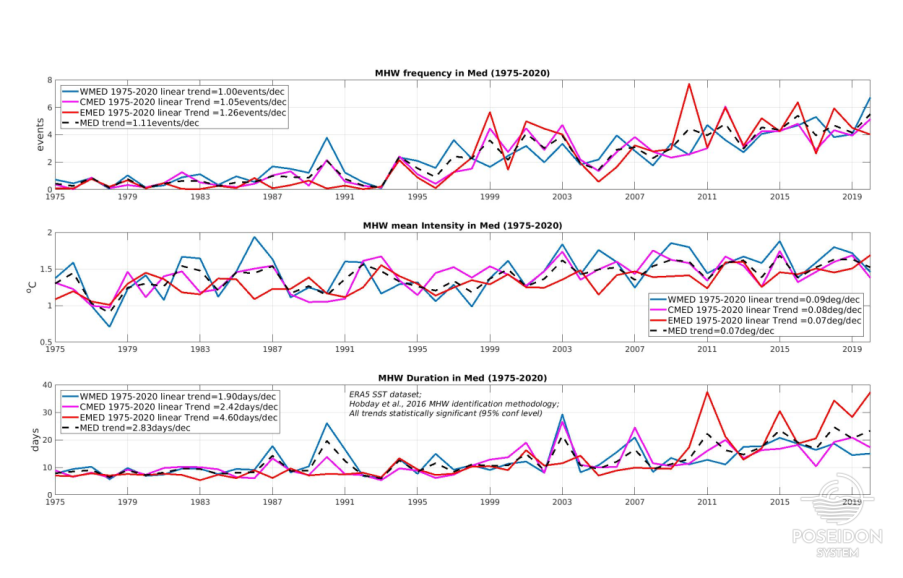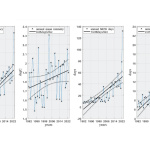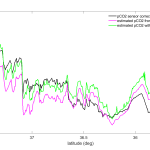POSEIDON & Climate monitoring: oceanic extremes
Written by D. Denaxa and the POSEIDON scientific team
Deeper understanding of the ocean climate, including anthropogenic climate change and natural variability, is becoming more and more imperative. Monitoring the sea surface temperature –being a major climate change indicator– is of fundamental importance especially in highly vulnerable areas to climate change, such as the Mediterranean Sea [6, 11].
The Mediterranean Sea has been experiencing unprecedented surface warming during the past decades. In fact, it has largely exceeded the observed global sea surface warming trends [1, 15, 16]. Extreme oceanic events such as marine heatwaves (discrete warm ocean events lasting at least five consecutive days) have attracted great interest within the climate change community [2, 7, 8, 9, 12]. The POSEIDON team has also been studying the temporal evolution of these episodes over the past decades in the Mediterranean Sea. Results reveal a significant increase in their frequency of occurrence, their mean intensity (mean temperature difference with respect to climatology) and duration (Figure 1), in all Mediterranean sub-basins. The eastern Mediterranean Sea in particular presents the highest positive trends of occurrence frequency and event duration. To better illustrate this, less than one event per year would occur in the basin during the 70s, while during the last decade approximately five marine heatwaves per year are detected, each one lasting of about four times longer. Several studies based on observational and modelled temperature datasets point out the eastern Mediterranean basin as the area exhibiting the strongest surface warming [13, 15].
Availability of high quality oceanographic and meteorological observational data allows for properly reporting and analysing such events. In turn, such studies may provide significant baseline-knowledge for impact assessment. For instance, temperature recordings derived from two POSEIDON buoy stations moored in the southern Aegean (Ε1-Μ3Α and Ηeraklion Coastal Buoy (HCB)) have captured record-breaking sea surface temperature anomalies in mid May 2020 [3]. This specific event evolved in the eastern Mediterranean as a marine heatwave of category Extreme (Figure 2a,b). Atmospheric parameters recorded by these buoy stations as well as buoy measurements of temperature at several depths were additionally used to investigate potential driving mechanisms and the sub-surface conditions during the event, respectively. Temperature profiles from Argo floats recording in the eastern Mediterranean at that time provided further insight into the upper ocean stratification conditions before the onset, throughout the event-duration and after its decline (Figure 2c).
Marine heatwaves posing a high impact on marine life is already a fact. Massive geographical shifts, impacts on primary productivity, mass mortality events and several other direct and indirect threats for the marine ecosystems have been attributed to thermal stress under a warming Mediterranean climate [4, 5, 10, 14, 17, 18]. On top of this, future projections suggest that anthropogenic forcing will further increase marine heatwaves by 2100 in the basin, especially under high-emission scenarios [19].
On these grounds, it is crucial to promote infrastructures and research studies aiming to enrich the existing knowledge and increase awareness on the emergency character of this topic. Most importantly, maintaining a high quality network of continuously monitoring instruments is crucial for the implementation of reliable scientific climate-related studies.
References
- Bulgin, C. E., Merchant, C. J., & Ferreira, D. (2020). Tendencies, variability and persistence of sea surface temperature anomalies. Scientific reports, 10(1), 1-13.
- Darmaraki, S., Somot, S., Sevault, F., & Nabat, P. (2019). Past variability of Mediterranean Sea marine heatwaves. Geophysical Research Letters, 46, 9813– 9823. https://doi.org/10.1029/2019GL082933
- Denaxa D., Korres G., Sotiropoulou M., Perivoliotis L. (2022) Extreme Marine Heatwave in the eastern Mediterranean in May 2020. In: Copernicus Ocean State Report, Issue 6, Journal of Operational Oceanography, 15:sup1, s119–s126; DOI: 10.1080/1755876X.2022.2095169
- Frölicher, T.L., Fischer, E.M. & Gruber, N. Marine heatwaves under global warming. Nature 560, 360–364 (2018). https://doi.org/10.1038/s41586-018-0383-9
- Garrabou J, Coma R, Bensoussan N, Bally M, Chevaldonné P, Cigli- ano M, Diaz D, Harmelin JG, Gambi M, Kersting D (2009) Mass mortality in Northwestern Mediterranean rocky benthic com- munities: effects of the 2003 heat wave. Global Change Biol 15(5):1090–1103
- Giorgi F (2006) Climate change hot-spots. Geophysical research let- ters 33(8)
- Ibrahim, O., Mohamed, B., & Nagy, H. (2021). Spatial variability and trends of marine heat waves in the eastern mediterranean sea over 39 years. Journal of Marine Science and Engineering, 9(6), 643.
- Holbrook, N. J., Scannell, H. A., Sen Gupta, A., Benthuysen, J. A., Feng, M., Oliver, E. C., ... & Wernberg, T. (2019). A global assessment of marine heatwaves and their drivers. Nature Communications, 10(1), 1-13.
- Juza M, Fernández-Mora À and Tintoré J (2022) Sub-Regional Marine Heat Waves in the Mediterranean Sea From Observations: Long-Term Surface Changes, Sub-Surface and Coastal Responses. Front. Mar. Sci. 9:785771. doi: 10.3389/fmars.2022.785771
- Leach, T. S., BuyanUrt, B., & Hofmann, G. E. (2021). Exploring impacts of marine heatwaves: paternal heat exposure diminishes fertilization success in the purple sea urchin (Strongylocentrotus purpuratus). Marine Biology, 168(7), 1-15.
- Lionello, P., Malanotte-Rizzoli, P., & Boscolo, R. (Eds.). (2006). Mediterranean climate variability. Elsevier.
- Oliver, E. C., Donat, M. G., Burrows, M. T., Moore, P. J., Smale, D. A., Alexander, L. V., ... & Wernberg, T. (2018). Longer and more frequent marine heatwaves over the past century. Nature communications, 9(1), 1-12.
- Pastor F, Valiente JA, Khodayar S. A Warming Mediterranean: 38 Years of Increasing Sea Surface Temperature. Remote Sensing. 2020; 12(17):2687. https://doi.org/10.3390/rs12172687
- Pearce, A. F., & Feng, M. (2013). The rise and fall of the “marine heat wave” off Western Australia during the summer of 2010/2011. Journal of Marine Systems, 111, 139-156.
- Pisano A, Marullo S, Artale V, Falcini F, Yang C, Leonelli FE, Santoleri R, Buongiorno Nardelli B. New Evidence of Mediterranean Climate Change and Variability from Sea Surface Temperature Observations. Remote Sensing. 2020; 12(1):132. https://doi.org/10.3390/rs12010132
- Shaltout, M.; Omstedt, A. Recent sea surface temperature trends and future scenarios for the Mediterranean Sea. Oceanologia 2014, 56, 411–443
- Smale, D. A., Wernberg, T., Oliver, E. C. J., Thomsen, M., Harvey, B. P., Straub, S. C., Burrows, M. T., Alexander, L. V., Benthuysen, J. A., Donat, M. G., Feng, M., Hobday, A. J., Holbrook, N. J., Perkins-Kirkpatrick, S. E., Scannell, H. A., Gupta, A. S., Payne, B. L., & Moore, P. J. (2019). Marine heatwaves threaten global biodiversity and the provision of ecosystem services. Nature Climate Change. https://doi.org/10.1038/s41558-019-0412-1
- Wernberg T, Bennett S, Babcock RC, de Bettignies T, Cure K, Depc- zynski M, Dufois F, Fromont J, Fulton CJ, Hovey RK et al. (2016) Climate-driven regime shift of a temperate marine ecosystem. Science 353(6295):169–172
- Oliver, E. C., Burrows, M. T., Donat, M. G., Sen Gupta, A., Alexander, L. V., Perkins-Kirkpatrick, S. E., ... & Smale, D. A. (2019). Projected marine heatwaves in the 21st century and the potential for ecological impact. Frontiers in Marine Science, 6, 734.










